03/08/2020
 The Ruger No.1 holds a unique place of honor at Real Guns®. Because it is stout, reliable and relatively easy to rebarrel, Ruger No.1s served as the basis for wildcat cartridge development, like the 358-378RG with 280 grain 35 caliber bullet zipping along at 3,100 fps. Ruger No.1s wired for strain to monitor chamber pressure have been used in our development of high performance 45-70 Gov’t, 375 H&H and 9.3x62mm handloads. Ruger No.1s in a variety of calibers are used for recreational target shooting and hunting.
The Ruger No.1 holds a unique place of honor at Real Guns®. Because it is stout, reliable and relatively easy to rebarrel, Ruger No.1s served as the basis for wildcat cartridge development, like the 358-378RG with 280 grain 35 caliber bullet zipping along at 3,100 fps. Ruger No.1s wired for strain to monitor chamber pressure have been used in our development of high performance 45-70 Gov’t, 375 H&H and 9.3x62mm handloads. Ruger No.1s in a variety of calibers are used for recreational target shooting and hunting.
Ruger describes the No.1 as an under-lever, falling block, single shot rifle. Early examples of hammerless, under-lever falling block rifles are the 1871 Martini-Henry and the 1872 Farquharson-Metford. Falling block rifles were routinely chambered for small bore through large bore nitro express cartridges and used extensively as firearms of choice on safari. The first big game rifle Walter Bell used in Africa was a .303 British Farquharson and later a .350 Rigby chambered Greener Farquharson.
The Ruger No.1 is patterned after the Farquharson, right down to the sweeping flourish of the under-lever and the stock’s raised side panels aft of the receiver. The Farquharson, in turn, is patterned after the earlier exposed hammer Alexander Henry. Both Bill Ruger and contributing gunsmith-stock maker Lenard M. Brownell openly designed the No.1 to emulate these early European firearms in the hope of creating a modern, mechanically refined classic. They succeeded.
|
Ruger No.1 Medium Sporter Single-Shot Rifle |
|
| Manufacturer | Ruger Firearms |
| Model | 21311 |
| Type | Under Lever Falling Block |
| Caliber | 475 Linebaugh / 480 Ruger |
| Capacity | 1 |
| Barrel Length | 20“ |
| Rifling | 1:18″ 5 Groove |
| Weight | 6 lbs 9 oz. |
| Overall Length | 36.50“ |
| Stock | American Walnut |
| Metal finish | Satin Blued Alloy Steel |
| Length of Pull | 13.50″ |
| Drop at comb | 0.50″ |
| Drop at heel | 0.75″ |
| Rear Sight | Folding Leaf on Quarter Rib |
| Front Sight | Ramped – Brass bead |
| Scope | Ruger Integral Base |
| Trigger Pull | *4 lbs.1 oz. |
| Safety | 2 Position Thumb Safety |
| MSRP | $1,919 |
“I’m pinned forward, Goose. I can’t reach the ejection handle…”
Hunting with a single shot rifle takes practice to develop marksmanship skill, as would be the case with any firearms, plus the ability to reload the firearm after each shot without hesitation. It’s enough to cause a 30 rounds per magazine AR 15 guy to break out in a rash. Fortunately, follow on shot reloading is not a difficult skill to master.
Some folks like their firearm to forcefully eject an empty so that the chamber is cleared and there is no chance of semi chambered spent brass getting in the way. Others like to empty brass extracted, but not tossed, especially when valuable brass that is slated for reloading is in play. The Ruger No.1 gives the shooter a choice as it can be configured to extract or eject and for greater or lesser ejection force.
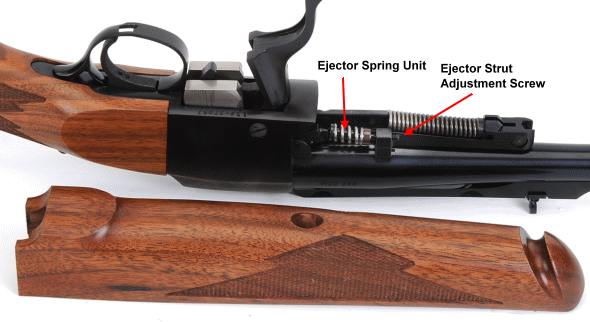
To convert the Ruger No.1 to extract only rather than extract and eject, the Ejector Strut Adjustment Screw is backed out until the Ejector Strut Spring is no longer preloaded and the Ejector Spring Unit is free and can be removed. With the unit in place, the Ejector Strut Adjustment Screw can be turned out or in to decrease or increase, respectively, the Ejector Spring preload.
I see, I sea, I C… A picture in a picture, in a picture
The quarter ramp is an age old method of providing a sight system that is parallel to a firearm’s bore, with the bottom contact surfaces conforming to a barrel’s taper.The bottom side of the quarter ramp is relieved where contact is not necessary to reduce the effects of barrel generated heat and hoop stress.
In this case, the quarter ramp sides are scalloped and the top is coin slotted to accommodate Ruger scope rings, preventing lateral, longitudinal and vertical scope mount movement. The small, folding leaf sight is screw driver adjustable for elevation and drift adjustment for windage. Yes, if you drift sights you would be technically correct in referring to yourself as a drifter, so you would have to get used to wandering from town to town, assuming a meaningless existence or learn how to sing.
The genius of the No.1
Without the need to accommodate a feed mechanism as physically long as an associated cartridge, the action only needs to be large enough to secure a substantial breech block and provide support of the same.
Having a short action like the No.1 means a rifle with an overall length approximately 4″ shorter than a bolt action. A breech block, in the form of a big chunk of steel trapped in the grasp of the thick steel receiver, can not move backward or side to side, only up and down with the shooter’s deliberate motion of the under lever. Modern Ruger No.1 rifle triggers are easy to adjust, but we will save that for another time.
The Ruger’s buttstock grip is shotgun like; the long slender wrist, sweeping pistol grip and checkering patterns that follow form nicely. The recoil pad is more than adequate because of its resilient structure. Nice not to have a giant foam filled inner tube at the butt end of a rifle you are trying to shoulder.
I used to petition Ruger marketing for the creation of a half size action of this type in a rifle chambered for the 218 Bee, 219 Zipper, 22 K Hornet and, possibly, the 222 Remington. Something to replace the Martini Cadet action… 20″ heavy barrel, beavertail forearm, high comb buttstock. I think the formal Ruger responses were “Huh?”, “What?”, “Really?”, and “Huh?”. I will try again as soon as they lift the TRO and I get their new phone number.
A encapsulated history of the 475 Linebaugh… really
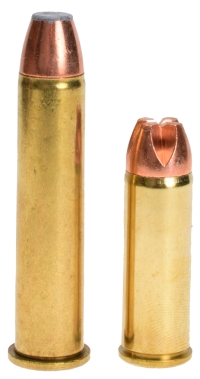 John Linebaugh is a very talented gunsmith/cartridge wildcatter who specializes in producing big bore handguns that most of us lack the handgun skills or physiological gumption to shoot… but must shoot anyway. Linebaugh also developed a body of scientifically substantiated work that defines the potential of the 45 Colt cartridge in modern, stout firearms.
John Linebaugh is a very talented gunsmith/cartridge wildcatter who specializes in producing big bore handguns that most of us lack the handgun skills or physiological gumption to shoot… but must shoot anyway. Linebaugh also developed a body of scientifically substantiated work that defines the potential of the 45 Colt cartridge in modern, stout firearms.
Linebaugh produced two well known cartridges, the 500 Linebaugh (circa 1986) which is based upon a shortened and expanded 348 Winchester brass and the subject cartridge, the 475 Linebaugh (circa 1988), which is based upon a shortened 45-70 Gov’t case. Both cartridges have a 50,000 PSI Maximum Average Pressure rating. The 500 Linebaugh has an H2O spill over capacity of 59.0 grains and generates 1,200 fps of muzzle velocity with a 500 grain bullet from 5 1/2″ barrel revolver.
The 475 Linebaugh, a SAAMI standard cartridge, has an H2O spill over capacity of 49.0 grains and was listed by Linebaugh as generating 1,495 fps of muzzle velocity with a 370 grain bullet when fired from a 5 1/2″ barrel revolver. The current SAAMI standard is 400 grains @ 1,300 fps from a 7.5″ vented test barrel and 1,400 fps from an unvented test barrel.
The subject Ruger No.1 is listed as being also compatible with the 480 Ruger.cartridge. Also based on the 45-70 Gov’t cartridge. The 480 Ruger it is shorter than the 475 Linebaugh with an H2O capacity of 44.0 grain. It is SAAMI listed with a 48,000 maximum average pressure and a standard velocity of 325 grain bullet @1,425 fps. I find it is significantly easier to shoot than the 475 Linebaugh, which is supported by objective measurement. Where the shooting arm rotates 90° when firing a 480 Ruger revolver, it rotates a full 360° with the 475 Linebaugh. Some big game hunters find the latter a better situation because it automatically aligns the shooter for a quick follow on shot. Below L-R 454 Casull, 480 Ruger and 475 Linebaugh.
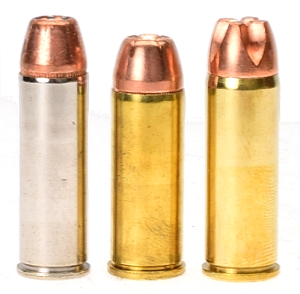
We are changing the photo light set up, which should eventually lead to better photographic results. Unfortunately, this article is becoming the story of one man’s journey through soft/hard focus, varying color temperature, poor color saturation, low contrast, and guess which exposure. No, I don’t know what any of that means… which is why it is a struggle. I long for the old days, an hour ago, when I could just pick up my tired, beat up cameras and, without conscious effort, produce uniformly mediocre images. We’ll get there.
The Ruger No.1 / 475 Linebaugh combination…
Where the 475 Linebaugh was intended for handgun hunting large and dangerous game, it becomes an easy shooting big game cartridge. Makes sense as the 3.5 lb increase in weight over a 5 1/2″ barrel, single action revolver seriously dampens recoil and the 14 1/2″ increase in barrel length permits muzzle pressure to drop from approximately 8,500 psi to under 2,000 psi, bringing report down with it.
With the intention of developing handloads for the combination, I had only one type of factory ammunition on hand, Underwood 300 grain Xtreme Penetrator. I don’t know why companies within the firearm industry insist on misspelling common words as a marketing ploy, Why, oh why, oh why? Anyway, rated at 1,600 fps from a handgun, the 300 grain leadless bullet clocked 1,774 fps from the Ruger No.1. Scoped, 100 yard, 5 shot group sizes hovered around 1.2 to 1.5″. The holes are so big it is almost clover leaf territory. Biggest problem? Three sets of bore sight tools, laser and optical, all accommodate .45 caliber or .500 caliber, none covered .475 caliber. The upside, I got to shoot and walk a bit more.
The rifle is beautiful. After seeing Winchester, Browning and Remington high grade listed stocks move toward 2×4 stud lumber in terms of grain and figure, all of the Ruger No.1 rifles I’ve handled over the past few years have had really pretty stocks. Great American walnut figure, color and contrast with deeply blued metal pieces and very uniform finishes all around. Ruger has been very true to enthusiasts and products. The people I’ve met from customer service to senior management have been, and continue to be, in it for the long hall, care about the products they make and respect the customer.
Part II coming soon with, hopefully, some decent handloads for the Ruger and the 475 Linebaugh.

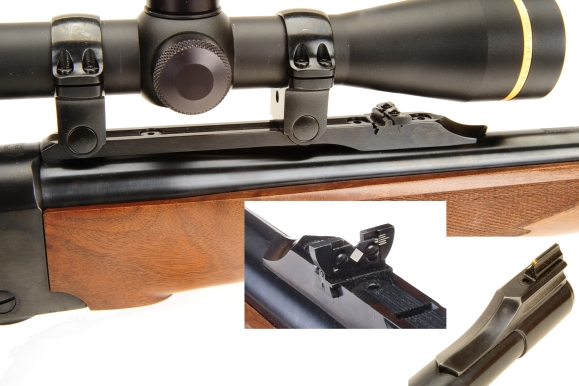

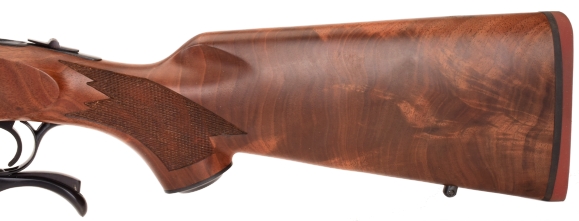

Email Notification